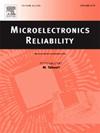Towards Extended Hückel model-based reliability performance enhancement of gate stack graphene nanoribbon field effect transistor
IF 1.9
4区 工程技术
Q3 ENGINEERING, ELECTRICAL & ELECTRONIC
引用次数: 0
Abstract
This paper examines the performance and reliability of the gate stack graphene nanoribbon field effect transistor (GS-GNRFET) with the varied number of carbon atoms along the graphene nanoribbon width (n) in the channel material. Initially, the Extended Hückel (EH) model approach is used to calculate bandgap and density of states (DOS) and transmission spectrum (TS) of bulk configured armchair graphene nanoribbon (ACGNR) with n = 4 and 7. Then, these ACGNR (n = 4 and 7) are used in channel material to analyze the performance of proposed devices, namely the A4 device (GS-GNRFET with ACGNR (n = 4) in channel material) and the A7 device (GS-GNRFET with ACGNR (n = 7) in channel material. The result shows that the bandgap value is lower in ACGNR (n = 7) with a value of 1.09 eV compared with ACGNR (n = 4). Also, the ACGNR (n = 7) shows improved DOS and TS. Also, the EH model shows good agreement with DFT methods, validating its reliability and efficiency for modeling ACGNR-based low-power devices. The variation in the value of ‘n’ from 4 to 7 enhances the on current (Ion, 481 times ↑), decreases off current (Ioff, 99.92 % ↓), improves the switching ratio (SR), reduces threshold voltage (Vth, 27 % ↓), reduces drain induced barrier lowering (DIBL, 16 % ↓) in A7 device as compared with A4 device. Also, the higher device efficiency (DE) value for the A7 device indicates lower voltage for significant current modulation, making it highly reliable for low-power applications. Moreover, the A7 device exhibits better transport properties, namely the Device Density of States (DDOS), projected density of states (PLDOS), transmission coefficient T (E), transmission pathways (TP), and Electron Difference Density (EDD). These parameters provide a unique way to evaluate device performance in terms of resonance peaks and electrical structure. The DDOS and contour plot of PLDOS analysis indicate a higher electron occupation, leading to better performance of the A7 device. The T(E) and TP analysis confirms stronger conductance, faster switching, and lower power consumption due to robust electron tunneling in the A7 device compared to the A4 device. The EDD analysis reveals more effective gate control with reduced electron density variations, resulting in improved switching behavior in the A7 device. Additionally, the A7 device has a very low value of static power (1.58 × 10−13 watt) compared to previous devices available in the literature. The improved findings regarding DE, SR, Vth (27 % ↓), DIBL (16 % ↓), TP, EDD, DDOS, and static power analysis of the A7 device make it suitable for applications in low-power areas like biomedical devices, sensors, and signal amplification areas. Owing to enhanced findings, this research article highlights the A7 device as a reliable and suitable candidate for low–power applications.
基于扩展h ckel模型的栅极堆石墨烯纳米带场效应晶体管可靠性性能增强研究
本文研究了栅极堆叠石墨烯纳米带场效应晶体管(GS-GNRFET)在沟道材料中沿石墨烯纳米带宽度(n)变化的碳原子数下的性能和可靠性。首先,采用扩展h ckel (EH)模型方法计算了n = 4和7的扶手椅型石墨烯纳米带(ACGNR)的带隙、态密度(DOS)和透射谱(TS)。然后,将这些ACGNR (n = 4和7)用于通道材料,分析所提出器件的性能,即A4器件(在通道材料中添加ACGNR (n = 4))和A7器件(在通道材料中添加ACGNR (n = 7))。结果表明,与ACGNR (n = 4)相比,ACGNR (n = 7)的带隙值较低,为1.09 eV。同时,EH模型与DFT方法的一致性较好,验证了该模型对基于ACGNR的低功耗器件建模的可靠性和有效性。与A4器件相比,n从4到7的变化增加了导通电流(Ion, 481倍↑),减小了关断电流(Ioff, 99.92%↓),提高了开关比(SR),降低了阈值电压(Vth, 27%↓),降低了漏极诱导势闸降低(DIBL, 16%↓)。此外,A7器件的器件效率(DE)值越高,意味着电流调制的电压越低,使其在低功耗应用中非常可靠。此外,A7器件具有更好的传输特性,即器件态密度(DDOS)、投射态密度(PLDOS)、传输系数T (E)、传输路径(TP)和电子差密度(EDD)。这些参数提供了一种独特的方法来评估器件在共振峰和电结构方面的性能。从PLDOS分析的DDOS和等高线图可以看出,A7器件的电子占用率较高,因此具有较好的性能。T(E)和TP分析证实,与A4器件相比,A7器件具有更强的电导,更快的开关和更低的功耗,这是由于A7器件中强大的电子隧穿。EDD分析揭示了更有效的栅极控制,减少了电子密度变化,从而改善了A7器件的开关行为。此外,与文献中先前的器件相比,A7器件具有非常低的静态功率值(1.58 × 10 - 13瓦)。A7器件在DE、SR、Vth(27%↓)、DIBL(16%↓)、TP、EDD、DDOS和静态功耗分析方面的改进结果使其适用于生物医学设备、传感器和信号放大等低功耗领域的应用。由于增强的发现,这篇研究文章强调了A7器件作为低功耗应用的可靠和合适的候选者。
本文章由计算机程序翻译,如有差异,请以英文原文为准。
求助全文
约1分钟内获得全文
求助全文
来源期刊

Microelectronics Reliability
工程技术-工程:电子与电气
CiteScore
3.30
自引率
12.50%
发文量
342
审稿时长
68 days
期刊介绍:
Microelectronics Reliability, is dedicated to disseminating the latest research results and related information on the reliability of microelectronic devices, circuits and systems, from materials, process and manufacturing, to design, testing and operation. The coverage of the journal includes the following topics: measurement, understanding and analysis; evaluation and prediction; modelling and simulation; methodologies and mitigation. Papers which combine reliability with other important areas of microelectronics engineering, such as design, fabrication, integration, testing, and field operation will also be welcome, and practical papers reporting case studies in the field and specific application domains are particularly encouraged.
Most accepted papers will be published as Research Papers, describing significant advances and completed work. Papers reviewing important developing topics of general interest may be accepted for publication as Review Papers. Urgent communications of a more preliminary nature and short reports on completed practical work of current interest may be considered for publication as Research Notes. All contributions are subject to peer review by leading experts in the field.
 求助内容:
求助内容: 应助结果提醒方式:
应助结果提醒方式:


